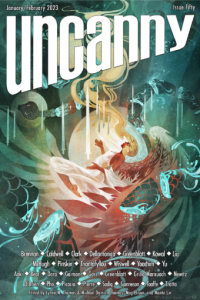Paul Di Filippo reviews Robert Moore Williams
If we regard the world of literature and publishing as a forest ecosystem, then somebody has to be the mulch, the humus, the duff. It’s not a glamorous role. You’re not a giant sequoia or even a pretty little mountain laurel shrub. You’re the compost, the soil that supports everything else. Humble, overlooked, but essential.
Okay, maybe that metaphor can be stretched to the snapping point. But still, that near-anonymous supportive functionality is always how I think of a certain tier of writers. They had long, productive careers, selling books, providing mild pleasure to many readers, somehow serving as a foil to the luminaries of the genre. Taken together, they were the substrate of competence on which the masters flourished. You can’t have a genre composed of one-hundred-percent geniuses, simply because there aren’t enough geniuses to go around. Modern commerce and the recreational demands of consumers mean there has to be a pipeline full of decent but nearly interchangeable product all the time.
But guess what? Sometimes reading these humus authors delivers a certain kind of modest, unique pleasure otherwise unobtainable. With them, you don’t confront the pressure of being worthy of their masterpieces. They labored in quiet and without expectations or constraints, rewarded so long as they delivered on time. Occasionally their work bordered on the surprising, and even the brilliant. Also, after enough time has passed, their work evokes a greater nostalgia, because it is generally timebound, a distinctive product of the era, rather than some timeless, transcendent work of genius.
By any standard, the forgotten Robert Moore Williams was one such figure. Here’s what the Science Fiction Encyclopedia has to say about him. “[By] the 1960s [he] had published over 150 stories. Though most are unremarkable, he was an important supplier of competent genre fiction during these decades, and tales like “Robot’s Return” (September 1938 Astounding)…retain a dawn pathos.”
If you want to sample Williams’s work in a very handy and attractive format, you should pick up the new collection from Armchair Fiction, a fine firm that specializes in reprints of neglected writers, as well as lesser-known items from the famous.
I’ll put the original sources for these tales in parentheses. The litany of old zines is potent in itself.
The volume opens strongly with “Time Tolls for Toro” (Amazing, 1950). Right from the start we sense that Williams can command an emotional immediacy and impact which overcomes his often blunt prose and erratic plotting. A man is walking down a city street in a kind of automatic fugue state, unknowing of his own identity or much else. Williams gives us a red herring, with news that police are looking for an escaped killer named Toro. Is this our hero? But no, he proves to be William Sumner, the inventor of time travel. We also get a beautiful mystery woman, and the eventual appearance of Toro, who proves to have surprises of his own. There’re kidnappings and cloak and dagger stuff and a gruesome set piece of mass murder by Toro, and then everything is resolved rather matter-of-factly. Endings were not Williams’s strong suit. But while the van Vogtian or Phildickian confusion is ongoing, it’s marvelous.
“Find Me In Eternity” (Amazing, 1951) posits an immortal man improbably chancing upon one of his contemporary descendents who just happens to be a scientist questing for life extension techniques. Old Harold and Young Harold band together, then run afoul of a greedy elderly millionaire. They escape and mercifully leave their antagonist to die eventually of old age. Williams’s prose, while always plain, contains some good metaphors. “Groff was the kind who always went towards ghosts.” But note that Williams, economical and hack-like, would use the exact same metaphor in the next story—or vice versa, actually, since the third story in the book was printed prior to the second. Misleadingly titled for maximum titillation, “The World of Reluctant Virgins” (Amazing, 1950) has a great conceit: the first rocket to the Moon lands in 1955, but finds that an expedition from 1887 has been there before them—and left descendents of the crew, who harbor a big secret.
Like a combination of Asimov’s robot stories and Simak’s robot stories, “The Soul Makers” (Super Science Stories, 1950) takes us to the far-off year of 1987, in the middle of an atomic war. Humanity’s sentient robots are going AWOL, and the two men sent to discover the reason uncover more than they anticipated. Williams extracts a fair measure of pathos from the noble actions of the robots, and the inevitable doom and rebirth of humanity.
“The Diamond Images” (Fantastic Universe, 1959) is one of those “Old Venus” tales so common in the consensus future history of this era. A butterfly collector named Wolder has made friends with the seemingly unsophisticated Venusians after eight years among them. But then his son arrives, unwittingly leading pirates to the treasure of the natives. The reader of 2014—and, probably, the reader of 1959—suspects early on that the natives conceal powers that will confound the pirates. One also notes that in the nine years separating the 1950 stories from this one, Williams has not altered one jot or tittle of his style or techniques, as a better writer might have.
Guess what happens in “When the Spoilers Came” (Planet Stories, 1952). An Earthman living peaceably among Martians finds the arrival of his marauding son to be a tragic occurrence that upsets the status quo and reveals the natives as secretly masterful. Well, no point in not reusing this good riff seven years later, with the setting changed to Venus, as above.
There’s an almost Ballardian feel to the opening of “To the End of Time” (Super Science Stories, 1950). A Venusian song, brought back to Earth, is literally driving people insane. Into the jungle wastelands of Venus, our psychologist hero Thorndyke sets out to find a cure, encountering a strange race of Venusians and the human missionary and his beautiful daughter who minister to them. Williams had a firm handle on Blue Book-style pulp templates, but never wrote an actual “Bat Durston” tale, always making his genuine speculative content integral to the mundane trappings.
Save for a few continuity changes, “The Metal Martyr” (Amazing, 1950) might almost be a sequel to “The Soul Makers,” featuring primitive humans and their robot inheritors. The robot protagonist undergoes a surprisingly Christ-like transformation. “Danger Is My Destiny” (Amazing, 1950) delivers more van Vogtian identity confusion and superman tropes, in a kind of Raymond Chandler or Cornell Woolrich guise.
Quite surprisingly, there’s a bit of real Theodore Sturgeon grace to “This Way Out” (Amazing, 1950). A young slum kid with mysterious psychic powers is befriended by an older man. We get a big reveal about the old guy’s true identity, then a second, contradictory reveal, then an emotional punch about his backstory. This might be the most organic and best constructed story of the lot. And finally “The Man from Space” (Imaginative Tales, 1957) follows the exploits of cab driver Little Joe as he willingly encounters flying saucers and their inhabitants, hoping to serve mankind’s conquerors.
Reading this volume is no chore or dull swotting up of past history for academic purposes. The stories, however creaky at times, remain very entertaining and illustrative of the mind and soul of one honest creator, doing the best he could to enrich the soil of the genre.









Nice review, I ordered the book. Now, if the publisher would please do the same for Theodore R. Cogswell.
Nice one, Paul!